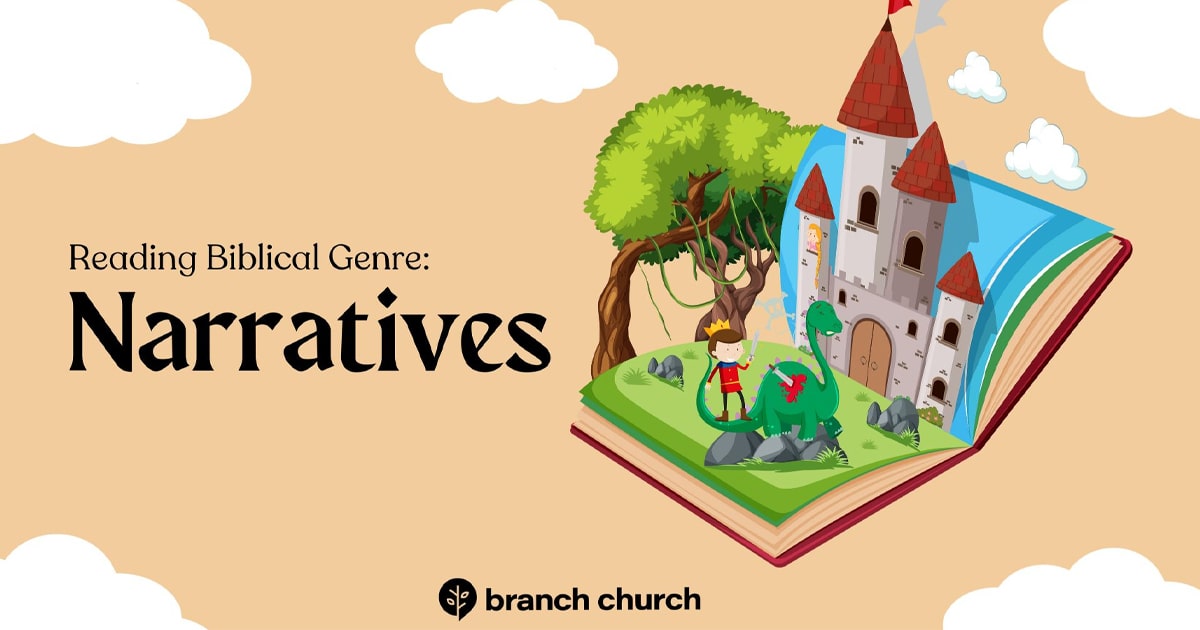
October 16, 2025
Reading Biblical Genre: Narratives
The funny thing is that most people already know the basics of how to do it. When you watch episodes of your favorite show you can discern its parts. There was the opening scene that grabbed my attention, the rising action and dialogue of the characters, the climax where all the problems converged, followed by the falling action and resolution.1 We’ve seen enough movies and shows to recognize this.
The Scene
The narratives of Scripture follow a similar format. They have a beginning and an ending point. The action/dialogue rises in the middle whereby the climax brings the problems together, followed by a resolution. Knowing this helps us to read narratives with more confidence. These patterns grant us predictable expectations so that we can follow the author’s progression and instruction.
For example, notice the flow of thought from 1 Samuel 17.
- Opening Scene (17:1–11): The Philistines gathered their armies for battle where a giant champion named Goliath challenged Israel to fight him. Israel, including their king Saul, were dismayed and afraid.
- Rising Action (17:12–40): David, the sheepherder boy and youngest of eight, is sent to bring provisions and hears the defiance of Goliath. David is brought before Saul where he demonstrates his past bravery and commits to fight Goliath.
- Climax (17:41–51): David takes down Goliath with a sling and a stone and cuts off his head.
- Falling Action + Resolution (17:52–58): Israel pursued and plundered the Philistines. Saul learns who David is.
Thus, identifying the parts of the scene enabled us to see the problem—a defiant and terrifying giant threatening God’s people; its resolution—an unlikely and unassuming boy within Israel; and how it came about—a single shot of the sling.
The Dialogue/Action—God’s Covenant Character
The scenes of Scripture are doing more than telling a story in history, they are revealing the God of all history. We want to do more than map out a scene; we want hear what the author is communicating to us. How do we do that? This happens through words and actions. Therefore, after discerning the scenes parts, it’s time to pay attention to the actions and dialogue in the scene. What is being communicated about God here is most essential.
In the case of 1 Samuel 17, God doesn’t directly speak. But in the dialogue between David and Goliath, he states (1 Sam. 17:47), “[A]nd that all this assembly may know that the LORD saves not with sword and spear. For the battle is the LORD’s, and he will give you into our hand.” The main point of the entire narrative is discerned in David’s speech and subsequent action—that the battle is God’s; that He saves and He saves without the powerful weapons of man.
We may learn many things from narratives, but we must always remember that God is the main character. Yes, David was brave, but why was David brave? 1 Samuel 16 tells us that God filled him with His Spirit (1 Sam. 16:13). Yes, David beat Goliath, but why did David beat Goliath? He was God’s chosen instrument (1 Sam. 16:12). The secondary characters help us to understand the main character—God. As you navigate the scene’s dialogue and actions, make sure that God’s covenant character is first and foremost on your mind. How is God being shown here? How does God relate to His covenant promises and covenant cursing’s? God is what the Bible is all about.
Here are some additional examples of discerning the main idea from dialogue/action.
- 1 Samuel 24. “May the LORD therefore be judge and give sentence between me and you, and see to it and plead my cause and deliver me from your hand.” (1 Sam. 24:15). The main point thus arises from 1 Samuel 24—vengeance belongs to the Lord.
- 1 Samuel 25. “32And David said to Abigail, “Blessed be the LORD, the God of Israel, who sent you this day to meet me!” 33Blessed be your discretion, and blessed be you, who have kept me this day from bloodguilt and from working salvation with my own hand! (1 Samuel 25:32–33) The main point of 1 Samuel 25 is given to us—Yahweh is the restrainer of evil in His servants through his Word.
The Bible is God’s revelation with narrative scenes inside of bigger scenes inside of a grand scene. And all these are given in followable formats with discernable dialogue and action. May the Lord bless you to see Him, the Lord and Redeemer, in the grand historical-redemptive narrative of the Scriptures.
1I don’t remember where I found this pattern. However, the following link is very close. See MasterClass, Five-Acts Structure: How to Write Five-Acts Structures, March 7, 2022, https://www.masterclass.com/articles/five-act-structure.
